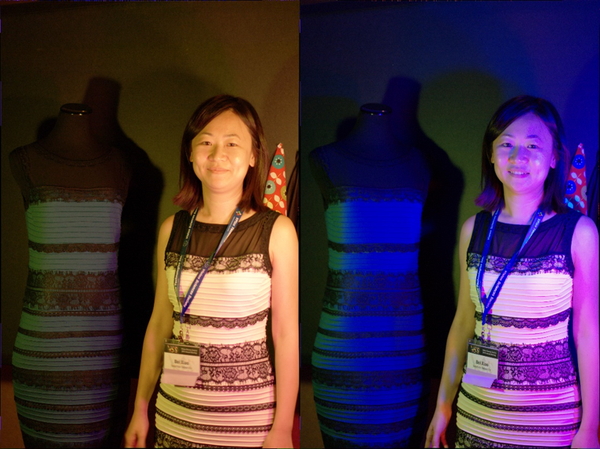This article was published in Scientific American’s former blog network and reflects the views of the author, not necessarily those of Scientific American
Our new column article (with co-author Bevil Conway, of Wellesley College & MIT)—on the topic of The Dress—came out on newsstands in Scientific American: Mind this week. In celebration of our new article, we thought we’d tell you about how the world’s largest vision sciences conference recently celebrated The Dress:
When vision scientists dress up, they really go out of their mind (and yours)! The international community of visual perception scientists held their annual conference, the Vision Sciences Society conference, last month on St. Pete’s Beach in Florida, featuring a special Pavilion dedicated to the infamous color-changing Dress!
Vision science conferences include a mind-blowing mix of scientific approaches and discoveries:
On supporting science journalism
If you're enjoying this article, consider supporting our award-winning journalism by subscribing. By purchasing a subscription you are helping to ensure the future of impactful stories about the discoveries and ideas shaping our world today.
Hardcore psychophysics, in which scientists make careful and highly precise measurements of perception based on carefully controlled physical phenomena
Measurements of neural responses during visual information processing
New wacky visual illusions that delight, confuse, and challenge the community for explanation.
This year’s special event was dedicated to The Dress—the internet sensation in which the same picture of a dress mysteriously appeared as blue/black or white/gold to each of two halves of the world. We’ve previously reported, here at Illusion Chasers, some of the brain mechanisms underlying people’s perception of the dress, as well as new research discoveries about the dress that highlight the previously unknown significance of the color blue to how we reconcile ambiguity in color.
In The Dress Pavilion at the Vision Sciences Society conference, appropriately convened in a circus-tent-like atmosphere in the conference hotel, visual illusions rattled the minds of all who entered. Female and male scientists wore the dress proudly and reveled in its myriad colors. Every wavelength distribution known to humankind was shone on The Dress, challenging the cloth to split humanity into even more perceptual sub-groups. As if the blue-and-black versus white-and-gold riff wasn’t enough!
Carefully crafted demonstrations, which you could see and experience with thine own two eyes (rather than through the filtered lens of the internet), proved without a doubt that you should doubt what you perceive. Spectators found unambiguous evidence of the the brain’s inherent color ambiguity-solving systems. High-tech light sources, like the LED luminaire developed by the European Union’s HI-LED project, were employed to control the specific photonic wave fronts that impinged upon the dress. All to study a dress. A dress!
Although various factors play into the visual effects that create the dress illusion, fundamental to these are the brain’s color constancy system, which strives to see a given object as unchanging, even under different lighting conditions. This is a remarkable skill, because an object’s surface can be colored only by virtue of the photons it reflects from a light source. That is, every object is tinted by both the color of its surface (defined as its ability to reflect light of a particular wavelength distribution) and the color of the light source (which limits which wavelengths are actually present to be reflected by the surface). A tricky prospect for the brain. The dress defeats your brain’s color constancy system when reflecting blue and yellow light, because it just so happens to be blue and black (and the black lace is yellow under gold lighting). The result is that, under blue and gold light sources (as in the famous photo), your brain can’t determine if it’s looking at a blue-black dress under yellow light, or white/gold dress under blue light.
Here’s an image with vision scientist Bei Xiao (American University) showing that her white dress doesn’t appear to change color, even though you can tell that the light shining on her has different wavelengths in the two images. The blue/black dress in the background does indeed seem to change color, however, despite being exposed to the same light sources as Xiao, indicating that its properties have short-circuited your brain’s color constancy mechanism.

Caption: Scientist Bei Xiao wears a white/black dress no matter the light source, but the blue/black dress in the background appears to change color as the light source changes.
Credit: Maria Olkkonen
The Dress Pavilion was created and presented by these scientists:
Stacey Aston, Newcastle University
Kristina Denisova, Columbia University
Anya Hurlbert, Newcastle University
Maria Olkkonen, University of Pennsylvania
Bradley Pearce, Newcastle University
Michael Rudd, University of Washington
Annette Werner, University of Tuebingen
Bei Xiao, American University
Arthur Shapiro, Oliver Flynn and Erica Dixon from American University, Rosa Lafer-Sousa from MIT, and Bevil Conway from Wellesley College and MIT, also contributed laptop-based dress demonstrations.
Special thanks to the organizers of the Vision Sciences Society “Demo Night”—Gideon Caplovitz (University of Nevada, Reno), Arthur Shapiro (American University), Karen Schloss (Brown University) and Gennady Erlikhman (UNR)—all of whom so kindly documented the event.